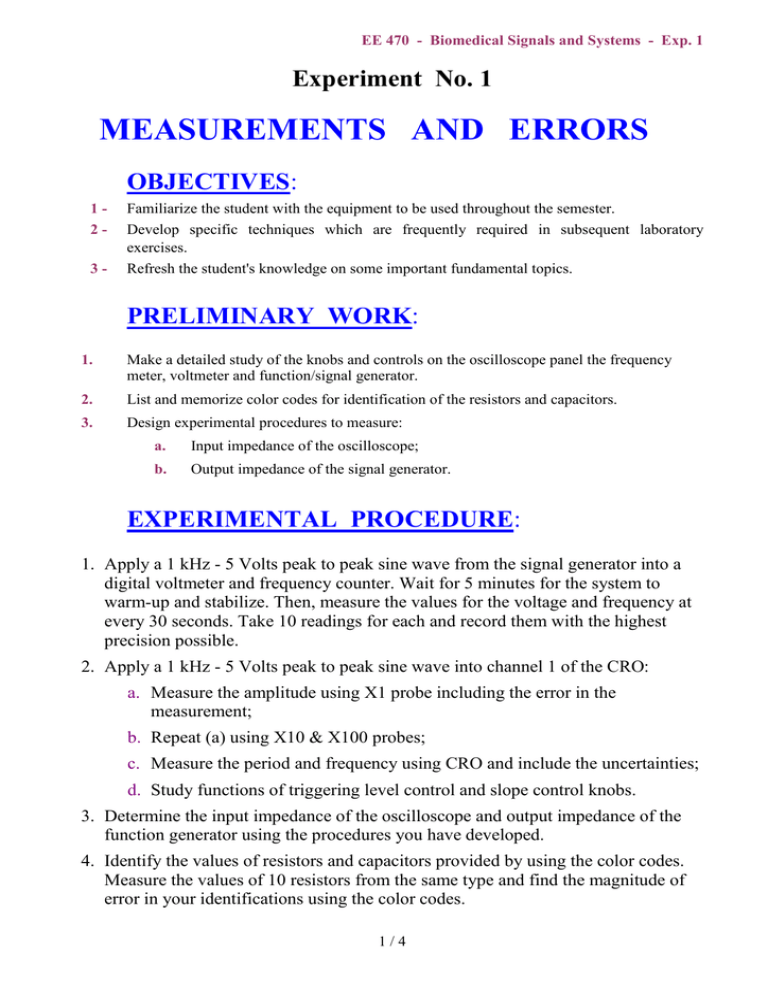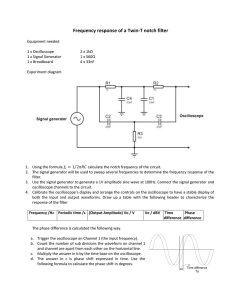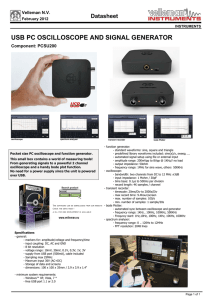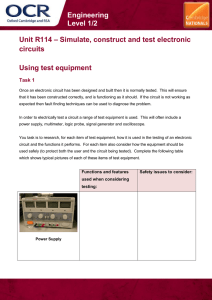Laboratory Experiments
advertisement

EE 470 - Biomedical Signals and Systems - Exp. 1 Experiment No. 1 MEASUREMENTS AND ERRORS OBJECTIVES: 123- Familiarize the student with the equipment to be used throughout the semester. Develop specific techniques which are frequently required in subsequent laboratory exercises. Refresh the student's knowledge on some important fundamental topics. PRELIMINARY WORK: 1. Make a detailed study of the knobs and controls on the oscilloscope panel the frequency meter, voltmeter and function/signal generator. 2. List and memorize color codes for identification of the resistors and capacitors. 3. Design experimental procedures to measure: a. Input impedance of the oscilloscope; b. Output impedance of the signal generator. EXPERIMENTAL PROCEDURE: 1. Apply a 1 kHz - 5 Volts peak to peak sine wave from the signal generator into a digital voltmeter and frequency counter. Wait for 5 minutes for the system to warm-up and stabilize. Then, measure the values for the voltage and frequency at every 30 seconds. Take 10 readings for each and record them with the highest precision possible. 2. Apply a 1 kHz - 5 Volts peak to peak sine wave into channel 1 of the CRO: a. Measure the amplitude using X1 probe including the error in the measurement; b. Repeat (a) using X10 & X100 probes; c. Measure the period and frequency using CRO and include the uncertainties; d. Study functions of triggering level control and slope control knobs. 3. Determine the input impedance of the oscilloscope and output impedance of the function generator using the procedures you have developed. 4. Identify the values of resistors and capacitors provided by using the color codes. Measure the values of 10 resistors from the same type and find the magnitude of error in your identifications using the color codes. 1/4 EE 470 - Biomedical Signals and Systems - Exp. 1 RESULTS AND DISCUSSIONS: 1. Record all measurements you have made. Compare them with your expectations. Discuss any difference you have encountered. 2. Discuss the accuracy of your measurements referring to the sources of errors. Study the accuracy and resolution of the measurement for the amplitude and frequency using: a. Oscilloscope only for the measurements; b. A digital multimeter and frequency counter for the measurements. Refer to manuals for the oscilloscope, multimeter and frequency counter if necessary (you can ask the help of the lab engineer). How many significant digits you can use to express the results in each case? 3. Discuss the relevance of the output impedance of the signal generator and input impedance of the oscilloscope. What limitations they introduce into your measurements? What is the significance of the input capacitance? 4. What can you say about the reliability of the measurement using oscilloscope? 5. Using statistical analysis find out the errors in amplitude and frequency of the signal delivered by the signal generator. 6. Determine the error in the resistance value and compare it to the tolerance. Express the resistance using significant digits only. Experiment No. 1 + INTRODUCTION TO LABORATORY EQUIPMENTS OBJECTIVE: The objective of this exercise has two fold: 1. To familiarize students with equipments to be used throughout the semester. 2. To develop specific techniques, which are frequently required in laboratory exercises. 2/4 EE 470 - Biomedical Signals and Systems - Exp. 1 THEORY OF EQUIPMENTS: 1. THE POWER SUPPLY UNIT 2. THE FUNCTION GENERATOR 3. THE DIGITAL MULTI-METER 4. THEORY OF OSCILLOSCOPE Since the oscilloscope is probably the most important tool of a circuit designer, trouble shooter, or instrumentation engineer and since many students lack enough understanding of its actual operation to be able to use effectively use its controls, a brief explanation will be presented. As evident, the utility of the scope lies in the fact that it displays graphically voltage functions in a circuit. This effect results from a beam of electrons being swept across the CRT face by plates with varying potentials. The face of the CRT is coated with phosphors which glow when struck by electrons. At higher sweep rates, the beam of electrons will strike the phosphors again before they have stopped glowing from this first contact. The result is a continuous history of the voltage fluctuation in the circuit. When the beam reaches the right side of the screen it is quickly brought back to the left side where another trace starts. If no attempt at synchronization is made, the beam will not begin at the same point during each cycle and the display will appear to float across the screen (this is analogous to the vertical rolling of the picture on a TV set). To eliminate this difficulty, internal circuitry is provided which holds the beam until a pre-set threshold voltage is reached (at which time the trigger, which may be a type of multivibrator, is tripped and the beam again sweeps across the screen). This is the essence of what is meant when someone uses the word "trigger" in reference to the oscilloscope. With this, the problem with floating is eliminated and the display will appear to be stable. It is often desirable to "trigger" the sweep on waveforms, which are external to the scope circuitry. This is accomplished using the front panel switch labeled Triggering Source. When this switch is in the internal (INT) position, a sample of the signal being displayed on CH1 is applied to the trigger circuit, and used for synchronizing the sweep generator. When in the external (EXT) position, a signal from some outside source is applied to the trigger circuit, and the sweep is synced to this signal. Note that the sync signal from an outside source must be applied through the external (EXT) connector. The LINE position of the switch synchronizes the sweep with the 60 Hz. The remainder of the controls, along with the other pieces of lab equipment, is fairly selfexplanatory and will be illustrated through experimentation. 3/4 EE 470 - Biomedical Signals and Systems - Exp. 1 EXPERIMENTAL PROCEDURE: Part 1: Use one channel of the scope and the waveform generator to perform the a) b) c) d) following tests. Frequency determination: Display two cycles of a 1 kHz sine wave, record the time base setting of the oscilloscope and, using this value, calculate it's frequency. Level control: Adjust the amplitude of the 1kHz sine wave to 6 volts peak to peak. Adjust the trigger level control until the sweep begins at -3 volts. Identify this waveform. Using the information presented in the background section, explain the function of this control (not what it appears to do!) Slope selector: Push the slope selector button in. Explain, using previous information, what function this performs concerning the triggering of the scope. Input coupling: Set the input-coupling switch on the scope to DC. Apply 5V p-p sine wave with maximum available positive offset. Push the coupling switch first to ground position (GND), and then to AC position. Describe what happens in all positions and hypothesize the function of the control. Part 2: From specification sheets find: a) b) The accuracy you can expect using the oscilloscope as a voltmeter and as a frequency meter. The input impedance. How it affects your measurement? Part 3: Set the following circuit onto the breadboard. Using both channels of the scope find the phase difference in degrees between the input and the output. The wave must be expanded to yield a convenient relationship between divisions on the screen and degrees. R = 33 kΩ Vout + Vin 5V p-p 1 kHz C=0.01µF Part 4: The circuit shown is commonly known as a voltage divider where + R1 Vo = Vin *[ R2 / (R1+R2) ] Vin Vout Use R1 = R2 = 4.7 kΩ. 5V p-p Then, use R1 = R2 = 4.7 MΩ. 1 kHz R2 Measure Vo and Vi using the oscilloscope. Is Vo=Vi/2? If not, explain the reasons. Part 5: Display two cycles of a 1 Hz, 3V sine wave using the storage facility of the CRO. Sketch the waveform obtained indicating the settings of the CRO. To use the storage facility: 4/4




